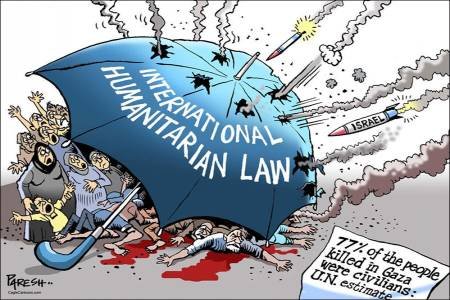Introduction
International Humanitarian Law is guarded by the International Committee of Red Cross (ICRC) which is also known as the promoter of International Humanitarian Law which describes it as:
“International Humanitarian Law is part of the body of international law that governs relations between states. It aims to protect persons who are not or are no longer taking part in hostilities, the sick and wounded, prisoners and civilians, and to define the rights and obligations of the parties to a conflict in the conduct of hostilities” [1]
Introduction of ICRC and Other Developments

The cornerstone of International Humanitarian Law is the Geneva Conventions. Protocols were added to the Geneva Conventions in 1977 and 2005, and a range of other international conventions and protocols covering specific areas such as conventional weapons, chemical weapons, landmines, laser weapons, cluster munitions and the protection of children in armed conflicts has developed the reach of International Humanitarian Law.
Alongside the Geneva Convention, the Hague Convention was created by the State in order to govern the wars. The Hague Conventions are various international treaties that emerged from the Hague Peace Conference in 1899 and 1907. The two conventions established a model for multilateral meetings to create international laws and subsequently influenced the formation of the league of Nations in 1919. After several years of these developments, World War II took place. ICRC’s role evolved, bringing it into direct and

continuous contact with the realities of war. It constantly urged governments to expand the reach of the law, which gradually came to cover warfare at sea, prisoners of war and civilians. The Swiss Government called for a conference and adopted four Geneva Convention, 1949.
The four protocols are as follows:
| CONVENTION | PROTOCOLS |
| I | On Wounded and Sick in the field.  Source: Click here |
| II | On Wounded, Sick and Shipwrecked at Sea.  Source: Click here |
| III | On Prisoners of War. Source: Click here |
| IV | On Civilians (in hands of enemy). Source: Click here |
The existing convention was re-written and the fourth was added for the protection of civilians who found themselves under enemy control. The Swiss Government organized a Diplomatic Conference with the aim to protect civilians which had been neglected before the Fourth Geneva Convention of 1949. This conference adopted Additional protocols to 1949 Geneva Conventions. Protocol I is applicable for InternationalArmed conflicts while Protocol II is applicable to non-international armed conflicts. These two protocols tremendously contributed in the development of International Humanitarian Law.
The 1977 Additional Protocols, relating to the protection of victims in both international and internal conflict, not only incorporated aspects of both the law of the Hague and the law of Geneva, but also various human rights provisions.
Basic Humanitarian Principles
| Soldiers who surrender or who are hors de combat are entitled to respect for their lives and their moral and physical integrity. It is forbidden to kill or injure them. |
| The wounded and sick must be collected and cared for by the party to the conflict which has them in its power. Protection also covers medical personnel, establishments, transports and equipment. The emblem of the red cross, red crescent or red crystal is the sign of such protection and must be respected. |
| Captured combatants are entitled to respect for their lives, dignity, personal rights and convictions. They must be protected against all acts of violence and reprisals. They must have the right to correspond with their families and to receive relief. |
| Civilians under the authority of a party to the conflict or an occupying power of which they are not nationals are entitled to respect for their lives, dignity, personal rights and convictions. |
| Everyone must be entitled to benefit from fundamental judicial guarantees. No one must be sentenced without previous judgment pronounced by a regularly constituted court. No one must be held responsible for an act he has not committed. No one must be subjected to physical or mental torture, corporal punishment or cruel or degrading treatment. |
| Parties to a conflict and members of their armed forces do not have an unlimited choice of methods and means of warfare. It is prohibited to employ weapons or methods of warfare of a nature to cause unnecessary losses or excessive suffering |
| Parties to a conflict must at all times distinguish between the civilian population and combatants in order to spare civilian population and property. Adequate precautions shall be taken in this regard before launching an attack. |
When does International Humanitarian Law apply?
International Humanitarian Law (IHL) is applicable in the situation of an armed conflict between the armed forces of two or more States or between the armed forces of a State and an organised resistance movement inside the country. It is not relevant for international humanitarian law to know about the reasons for the armed conflict. Only the fact that an armed conflict has arisen that international humanitarian law starts to step in.
Is war and armed conflict indirectly justified by International Humanitarian law?
No, International Humanitarian Law does not justify war. However, it does regulate war or armed conflict. It is not directly concerned with the issues of legitimization of violence. The primary concern of International Humanitarian Law is the protection of victims of any violence. The Charter of the United Nations prohibits war. The terms ‘jus in bello’ meaning the rules of international law related to regulation of armed conflict by promoting humanity and ‘jus ad bellum’ meaning rules of international law related to prohibition of the use of force against another nation plays a vital role throughout.
Classification of Armed Conflict
| Conflict arises when onenation State attacks another and the result is armed aggression |
| Conflict arises when in response to an armed attack, force is used by the victim State to defend itself exercising its right to self defense. In that effort, other friendly nations may join to support the victim state, resulting in collective self defence. |
| When the United Nations resolves to use force against the aggressor State. |
| When there occurs an armed conflict inside a nation state itself. Such situations are known as situations of civil war. |
Conclusion
In all these situations, there is a general agreement that rules of international humanitarian law would apply with the majority of its rules applying on the first three situations, and less number of rules applying to the fourth situation. Thus international humanitarian law becomes applicable during the times of war or armed conflict.
[1] International Committee of the Red Cross (ICRC), war and International Humanitarian Law (29 October 2010), https://www.icrc.org/en/doc/war-and-law/overview-war-and-law.htm (last visited 14 May 2021).

